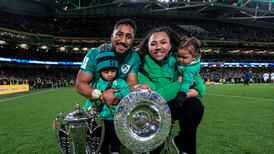Born: December 2nd, 1956
Died: May 20th, 2024
The Celtic Tiger denotes a period of unprecedented growth in the Irish economy from the mid-1990s to the early part of the new millennium. For most of the time since independence, Ireland had been characterised by sclerotic growth and high levels of emigration, but far-sighted reforms in the late 1980s and early 1990s reversed these trends.
From 1995 onwards Ireland posted some of the highest growth rates in the developed world. People migrated here in search of opportunities in the information and communications technology (ICT) sector, in particular. Indeed, Dublin became an important tech hub in Europe.
READ MORE
Fran Rooney, probably more than any other individual, embodied the transformation in the Irish economy. In 1996 he was part of a team that acquired Baltimore Technologies with the backing of Dermot Desmond, the businessman and financier.
Baltimore Technologies specialised in internet security. The company rode the wave of the dotcom boom. From 1997 onwards the conventional wisdom was that all business would migrate online. Companies merely had to add a dotcom to their name to see their valuations soar into the stratosphere.
Baltimore was developing encryption technology that would made ecommerce safe and trustworthy. It was inevitable that its valuation would also soar. From effectively a one-man outfit in 1996, it had a workforce of 1,500 by 1999. Along the way it had listed on the Nasdaq, the US market for technology companies. It also acquired a listing on the FTSE when it was taken over by Zergo in 1998, although Rooney remained at the helm.
The following year its market capitalisation had soared to $13 billion, putting Baltimore in the FTSE 100, an index of the most valuable companies on the London market. Rooney became one of the first Irish-born CEOs to join this exclusive club.
He never strayed from his working-class roots, and that, combined with an easy charm and a sense of humour, gave Rooney an air of authenticity often lacking in the corporate world. It also meant that he became a constant staple in Irish and international media. At the turn of the millennium Rooney looked to have made it. He was a paper billionaire with an international profile. He won a slew of business awards and was a sought-after speaker at the most exclusive tech conferences in the world.
He ensured that Baltimore employees shared the company’s success. Very generous share options meant that most of the workforce were paper millionaires.
But not everybody was convinced by the sustainability of Baltimore’s growth. There was a huge disconnect between its annual turnover and its valuation, although this was not uncommon in the gravity-defying era of the dotcom boom. Nevertheless, Desmond, who initially part funded the acquisition of Baltimore, began selling his shares following the acquisition by Zergo.
Desmond’s judgment was questioned when Baltimore’s share price continued to surge after his initial divestments, but he was soon proved right. When the dotcom bubble burst in 2000 Baltimore’s demise was unparalleled in the Irish corporate world. Rooney had sold shares worth €5.8 million before the value of the stock collapsed by more than 90 per cent but otherwise, in the space of a few months, his paper wealth disappeared.
Rooney stayed on as CEO and orchestrated a number of efforts to turnaround the fortunes of the company, which ultimately proved fruitless. He resigned in July 2001.
It was a spectacular fall from grace but outwardly, at least, Rooney remained sanguine. In an RTÉ documentary, Raging Bulls, broadcast in 2006, “je ne regrette rien” was his pithy response to a question about the Baltimore saga.
Football was one of Rooney’s most enduring passions throughout his life. He had played league of Ireland soccer with Home Farm, Shamrock Rovers, St Patrick’s Athletic and Bohemians. He managed the Irish women’s soccer team between 1986 and 1991.
And it was football that drew him back to the boardroom as a chief executive following his exit from Baltimore.
In 2003 the Football Association of Ireland (FAI) was still reeling from events at the 2002 World Cup. Roy Keane, the Ireland team captain, had been sent home by Mick McCarthy, the manager, amid rancorous exchanges about the state of the training camp in Saipan.
The government-commissioned Genesis Report into the Saipan affair was published in November 2002 and Rooney was brought in as CEO of the FAI in January 2003 to implement the recommendations of the report. But his relationship with the FAI board was difficult and he resigned in November 2004 when Milo Corcoran, the FAI chairman, failed to publicly express confidence in him. He was replaced as CEO of the FAI by John Delaney.
Rooney was born in Ringsend in December, 1956, the eldest of six children, to parents John and Dolores. The family subsequently moved to Cabra. He sat his Leaving Cert at Westland Row CBS, where he was described as being an intelligent and hardworking pupil.
Even though football was his main interest in his teenage years, he knew that he was not talented enough to make it as a professional in the English leagues. Instead he joined the Civil Service, moving between a few government departments before joining the finance division at An Post. He qualified as a chartered accountant in 1989 following three years of night school. In 1990 he left the public sector to pursue a number of roles in the private sector, including at National Irish Bank and Quay Financial Software, where he first came across Desmond, which would eventually lead to his role with Baltimore.
Rooney qualified as a barrister in 2008 at the age of 52. He remained intellectually curious and that guided many of his roles in later life. At the time of his death he was executive chairman of Blocknubie, a company focused on the emerging technologies of blockchain and artificial intelligence.
Rooney built an 8,000 sq ft house called Nirvana on the Castleknock Road when Baltimore was at its peak. He lived there with Mary, his wife, and three children, Yvonne, Dave and Laura. He and Mary subsequently separated.
Many of his former colleagues at Baltimore Technologies paid tribute to Rooney following his death. He was described as “kind, generous, positive and good natured”. Figures from the worlds of business, sport and the Law Library also paid their respects.
At his funeral Mass, Laura said her father had cherished his family more than anything. “His career often required extensive travel, [but] my father made it a priority to be home on weekends, ensuring he spent quality time with his family and friends,” she said.
“He used to visit, always remembering to bring Maltesers and often came to [his grandchildren’s] football matches,” she added.
Rooney is survived by his partner, Jackie, his former wife Mary, three children, their spouses as well as two grandchildren. He was predeceased by his parents and his brother Raymond.












